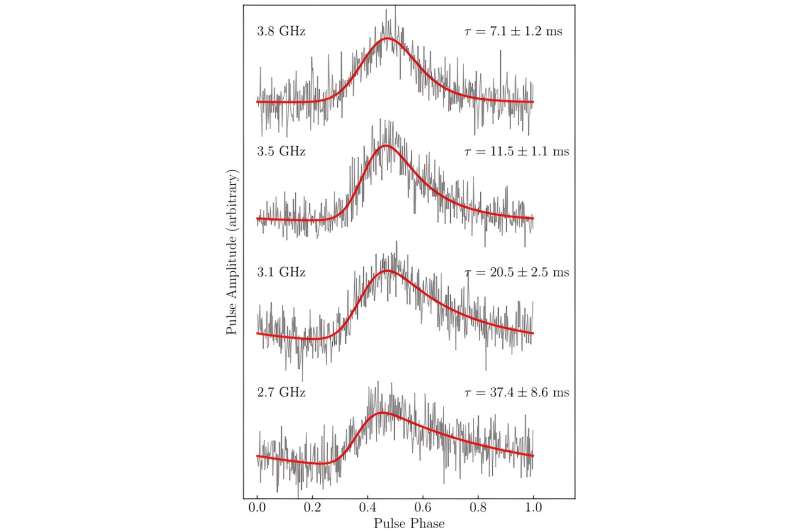December 4, 2023 report
This article has been reviewed according to Science X's editorial process and policies. Editors have highlighted the following attributes while ensuring the content's credibility:
fact-checked
preprint
trusted source
proofread
New young and highly scattered pulsar discovered with ASKAP

Using the Australian Square Kilometer Array Pathfinder (ASKAP), astronomers have discovered a new pulsar, which has received the designation PSR J1032−5804. The newfound pulsar turned out to be relatively young and highly scattered. The finding was reported in a paper published Nov. 25 on the pre-print server arXiv.
Pulsars are rotating neutron stars with intense magnetic fields, emitting a beam of electromagnetic radiation. They are usually identified in the form of short bursts of radio emission; however, some of them are also observed using optical, X-ray and gamma-ray telescopes.
Some radio pulsars are scattered as radio pulses from these objects traverse the turbulent interstellar medium and multi-path propagation causes temporal and spatial scattering. In general, highly scattered pulsars are hard to detect for the majority of astronomical surveys.
Now, a team of astronomers led by Ziteng Wang of Curtin University in Australia, reports the detection of such a highly scattered pulsar. PSR J1032−5804 was identified in the ASKAP Variables and Slow Transients (VAST) survey during a search for circularly polarized sources. Follow-up observations using the 64-m Parkes Radio Telescope and the Murchison Widefield Array (MWA) confirmed its pulsar nature.
The newly discovered pulsar is young as it has a characteristic age of 34,600 years. It has a long scattering timescale at 1 GHz—of about 3.84 seconds, which makes it the third most scattered pulsar known to date. This explains why PSR J1032−5804 has not been detected by previous pulsar surveys.
According to the study, PSR J1032−5804 has a period of 78.7 milliseconds, dispersion measure of approximately 819 pc/cm3, and rotation measure of about -2,000 rad/m2. The pulsar has a surface magnetic field strength of some 1.7 TG, and a spin-down luminosity of 2.9 undecillion erg/s.
ASKAP observations indicate that PSR J1032−5804 is a potential GPS (gigahertz-peaked spectrum) source and that it may host a pulsar wind nebula (PWN) and a supernova remnant (SNR) in its local environment. However, further studies are needed in order to confirm this.
Summing up the results, the authors of the paper noted that the discovery of PSR J1032−5804 is promising in the context of future discoveries of highly scattered pulsars.
"We can identify more highly scattered pulsars like PSR J1032−5804 with the high sensitivity and good resolution data from the ongoing ASKAP surveys. In the future, with the construction of next-generation radio telescopes such as the Square Kilometer Array, the Deep Synoptic Array, and the Next Generation Very Large Array, imaging domain searches will become a more powerful tool for discovering extreme pulsars (e.g., highly accelerated, highly scattered, and highly intermittent) that are hard to find via traditional surveys," the researchers concluded.
More information: Ziteng Wang et al, Discovery of a young, highly scattered pulsar PSR J1032-5804 with the Australian SKA Pathfinder, arXiv (2023). DOI: 10.48550/arxiv.2311.14880
Journal information: arXiv
© 2023 Science X Network




















